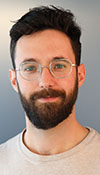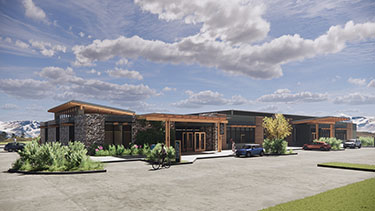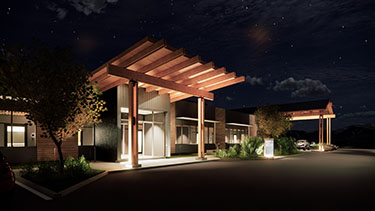|
Subscribe / Renew |
|
|
Contact Us |
|
| ► Subscribe to our Free Weekly Newsletter | |
| home | Welcome, sign in or click here to subscribe. | login |
Construction
| |
 |
May 11, 2023
Transforming the care model in the Rogue Valley
SABArchitects

Stevens |
Fundamentally, the team at Orthopedic Outpatient Center (OOC) knew that it wanted to provide a bespoke health care experience that prioritizes patients, staff, process clarity, and security. It knew that redefining the patient experience would begin with redefining the health care delivery process and program, so it sought out the Virginia Mason Institute, engaging the expertise of Chris Backous, a Lean and Transformative Care expert, to facilitate in a series of process improvement exercises.
“Going into the process improvement workshops, we had a broad desire to improve the staff efficiency, patient dignity and privacy, and also safety,” said Tammy Spohn, CEO of Orthopedic Outpatient Center. “The more hand-offs there are between care providers, the more risks there are for things to fall through the cracks. Our guiding principle was asking ourselves how we can maximize patient safety and provide a world-class patient and family experience.”
Orthopedic Outpatient Center engaged SABArchitects (SABA) to program, design and deliver the 30,815-square-foot freestanding ambulatory surgery center and physical therapy suite in Medford, Oregon.
SABA’s Phil Duff said, “The ambulatory surgery project for the Orthopedic Outpatient Center is organized like a machine designed to do two things: Provide operating rooms for outpatient surgeries and realize a concept for the patient spaces to increase patient satisfaction and improve safety.”
Designers often use 3P exercises (production, preparation and process) to pull together stakeholder groups to develop a new product or service concurrently with the process of delivery. In health care, the process often includes numerous 3P events assessing patient flows, material flows, and process flexibility through mapping and prototyping exercises. Each step pushes the product towards optimized experience, efficiency, and value.
However, as a new facility for OOC, the stakeholder groups did not yet exist — a challenge compounded by the pandemic that made what was once a robust series of in-person and hands-on processes impossible.
It became apparent that defining a new health care process and breaking out of the shell of prior care models would require OOC to begin onboarding its team of technical experts and care providers during the 3P process. OOC’s commitment to investing in its team and the process allowed for robust dialogues and buy-in, which heavily influenced the final care model. And the pandemic-driven digital summits quickly became a boon for team members across the country who could easily provide input months ahead of relocation to Medford.
The OOC team had never gone through a 3P process, having previously used the resources of local hospitals for its surgical processes. Backous helped the team to establish a set of guiding principles early in the process, an essential step that would help it make challenging decisions down the line.
Backous said, “It’s hard to attract and retain good people. OOC wanted to make sure that the space worked for their people and that those people would attract staff and patients.”
What emerged from the 3P was an innovative patient-focused flow diagram, which ultimately culled handoffs in the patient experience by condensing pre-op and recovery functions into a single universal room located adjacent to a complementary operating room. The program reinforces OOC’s Dedicated Care Model.
In a typical model, both the patient and the surgeon will commonly interact with an entanglement of three or more nurses with each different point of contact, creating an opportunity for error and increasingly impersonal experience for the patient. The Dedicated Care Model improves patient and care provider experiences by limiting the number of hand-offs and creating an all-day connection between the same surgeon, anesthesiologist, and dedicated nursing team for each patient. It is meant to develop an excellent rapport with the primary team internally and externally to maximize communication and efficiency. Executing the model required onboarding a team that understood the mission, the diagram, and the 3P practices that informed them.
OOC engaged SABA to bring the project to life based on SABA’s past performance delivering projects using Lean processes. Utilizing the DCM flow diagram, the SABA team began designing the patient experience and health care delivery flows. The ambulatory surgery center program includes six operating rooms, a clean-core, 20 private prep and recovery rooms, an on-site sterile processing department, a main nurse’s station with individual nurse’s perches at each room, administrative and staff support spaces, and a receiving area. The secondary program includes a 2,400-square-foot physical therapy space as well as a 1,250-square-foot tenant space.
“The appeal of this project was OOC, from day one, being committed to the Lean process improvement and innovation to meet their goals,” Duff said. “Many aspects of the project were tweaked through the design process, but we were ultimately able to realize their vision of the patient journey while incorporating building code and health care guidelines into the project.”
The program is organized into four concentric layers: Operating rooms are at the center of the diagram. Next, restricted circulation adjacent to operating rooms allows for the efficient transfer of staff and patients into and out of surgical spaces. Universal rooms make up the next layer, allowing patients to store their belongings, family members to visit and wait, and a familiar recovery place after operation. Finally, outer circulation creates a space of autonomy often lacking in healing environments; filled with natural light, the outmost corridor allows patients to self-room, family members to come or go from their rooms without hurdles, and easy egress and pickup when operations are complete.
At each main entry and exit — four in total — there is a prominent sloped wood canopy. This creates a clear hierarchy of entry and exit points. It also serves to break up the long facades. Between these entry points, SABA developed a simple rhythm of materials that alternate between wood, fiber cement panels, stone and EIFS — depending on your location around the building. The architectural design draws inspiration from both classic Pacific Northwest- and craftsman-inspired architecture. Key defining elements include the utilization of natural materials and the layering of both forms and textures. These elements, when put together, create a varied design that breaks up the building into smaller, human-scale moments related to patient movement and wayfinding.
SABA design lead Shaun Danielson said, “For the client, it was important to tie the patient experience to the aesthetics. This patient-forward approach led us to warm wood tones provided by cross-laminated timber beams, with vaulted ceilings to bring light into the space.”
The landscape design draws inspiration from the raw and natural landscapes found throughout the Rogue Valley. Planted areas will consist of native vegetation of varying heights, shapes and colors. The design brings the landscape directly up to the edge of the building, which makes the building feel grounded and natural. In addition, there will be substantial planting throughout the site, which will create pockets of usable outdoor space as well as screen the parking areas from adjacent properties and roads.
Together, the design elements make the new building seem at home in Medford. Soon, the space will become open to its first patients to begin putting the Direct Care Model to the test. OOC opens the doors to its new ambulatory surgery center in September.
Ian Stevens is the marketing and business development director at SABA. A University of Washington graduate, his interests include poetry, filmmaking, and the built environment.
Other Stories:
- Why Seattle has become a hotbed for life sciences
- New chapter for life sciences starts in the U District
- Tepid appetite for local lab space continues
- What does it take to convert offices to biotech lab space?
- Best practices for successful outcomes to complex health care projects
- ‘Supersized’ team finds success at Seattle Children’s Forest B
- Wellness nestles in the trees at The Evergreen State College
- The evolution of science: trends affecting the science workplace
- Considerations for successful adaptive reuse projects




